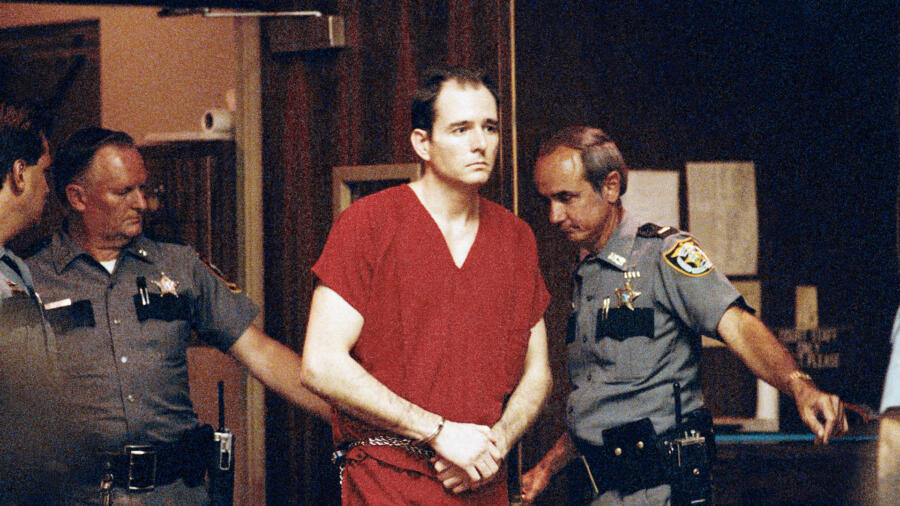In August 1990, Gainesville, Florida, transformed from a vibrant college town into a city paralyzed by fear. As news of five brutal murders spread, students at the University of Florida began locking their doors, sleeping in groups, and arming themselves for protection.
Over the course of just three days, a sadistic killer claimed the lives of five young people, leaving behind horrifying crime scenes. The man responsible was Danny Rolling, later known as the Gainesville Ripper. Although the murders stopped, the fear lingered—and so did the question: How was he finally caught?
A City in Panic: The Gainesville Murders Begin
On August 24, freshmen Sonja Larson and Christina Powell became the first victims. That evening, Rolling broke into their apartment, raped them, and stabbed them to death. Less than 24 hours later, he murdered Christa Hoyt, an 18-year-old student. In a grotesque display, he decapitated her and posed her body to taunt whoever found her.
By August 27, Rolling attacked again. He murdered roommates Tracy Paules and Manny Taboada, both 23. Although Manny fought back, he couldn’t overpower the killer. Tracy suffered the same fate as the previous victims.
Each scene revealed signs of ritualistic behavior—bodies posed, mirrors covered, and evidence of calculated cruelty. Panic swept through Gainesville as authorities struggled to identify the killer.
Police Chase the Wrong Suspect
With media pressure mounting and fear escalating, investigators arrested Edward Humphrey, a troubled UF student with a history of erratic behavior. His mental health issues and facial scars made him an easy target for suspicion.
However, the DNA evidence told a different story. It didn’t match. Humphrey was innocent.
Meanwhile, the real killer—Danny Rolling—sat unnoticed in a Marion County jail, arrested for an unrelated robbery. Police had no idea they already had him.
The Tip That Changed Everything
In Shreveport, Louisiana, Cindy Juracich watched the Gainesville news coverage with growing unease. The Florida murders reminded her of a triple homicide in her hometown the year before. Back then, someone had murdered Julie Grissom, her father Tom, and her nephew Sean in a similarly brutal fashion.
Cindy remembered a man named Danny Rolling, a drifter who had bragged about wanting to “stick knives in people.” She contacted police and urged them to look into him.
Investigators followed the lead. They soon discovered that Rolling had been arrested in Florida just days after the Gainesville killings. His DNA matched the evidence from all five crime scenes.
Thanks to one crucial tip, detectives had found the Gainesville Ripper.
Inside the Mind of Danny Rolling
Rolling’s childhood laid the foundation for his violent tendencies. His father, a police officer, abused him relentlessly. His mother attempted suicide several times, and their household overflowed with trauma. Rolling often ran away and eventually turned to crime.
Before arriving in Florida, Rolling had already murdered three people in Louisiana. He had entered the Grissoms’ home, killed them, and staged the bodies. The level of violence and posing matched the Gainesville scenes perfectly.
In Rolling’s mind, he wasn’t just a killer—he was building a legacy of terror.
Danny Rolling’s Trial and Shocking Confession
In 1994, Rolling’s trial finally began. To the shock of the courtroom, he confessed to all five Gainesville murders on the very first day. Rather than deny or delay, he admitted everything.
His defense attorneys argued that he suffered from multiple personality disorder. They claimed his violent alter ego, “Gemini”—inspired by a character from The Exorcist III—had committed the murders.
Still, the jury didn’t buy it. They recommended the death penalty, and the judge agreed.
Justice Delivered: Danny Rolling’s Execution
After more than a decade of appeals, Rolling faced execution on October 25, 2006. He sang a gospel hymn as the lethal injection took effect. He was 52 years old.
Before his death, Rolling submitted a written confession to the 1989 Shreveport murders, confirming suspicions that he had killed before Gainesville.
His execution closed a dark chapter, but the impact of his crimes still echoes across Florida.
FAQs: Gainesville Ripper Danny Rolling
Who was Danny Rolling?
He was a drifter from Louisiana who murdered five college students in Gainesville, Florida, in 1990.
How did police finally catch him?
Rolling was arrested for robbery shortly after the murders. A tip from a woman in Louisiana led police to match his DNA to the Gainesville crime scenes.
Why was he called the Gainesville Ripper?
His brutal, ritualistic killings and the speed with which he struck earned him comparisons to Jack the Ripper.
Did he commit other murders?
Yes. He confessed to the triple homicide of the Grissom family in Louisiana in 1989.
Was he mentally ill?
His defense claimed he had multiple personalities, but experts and the jury found him competent for trial.
When was he executed?
October 25, 2006, by lethal injection in Florida.

